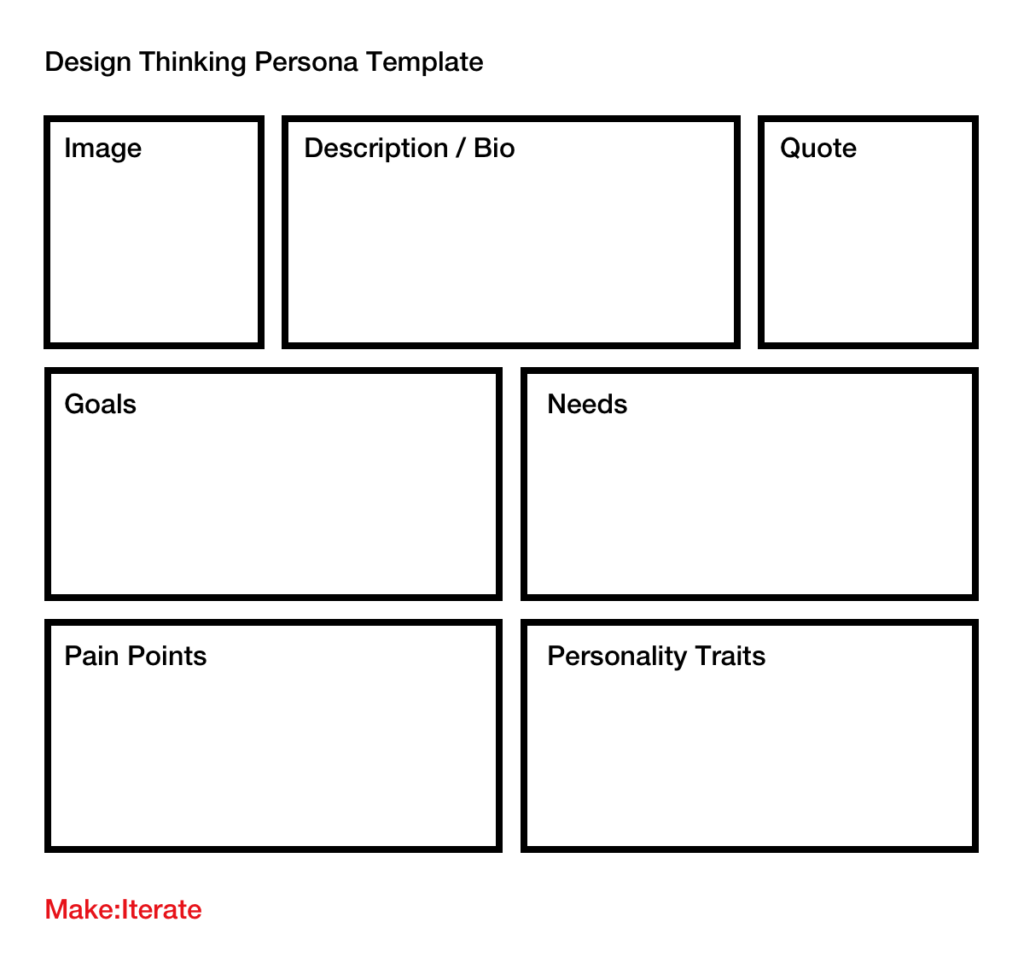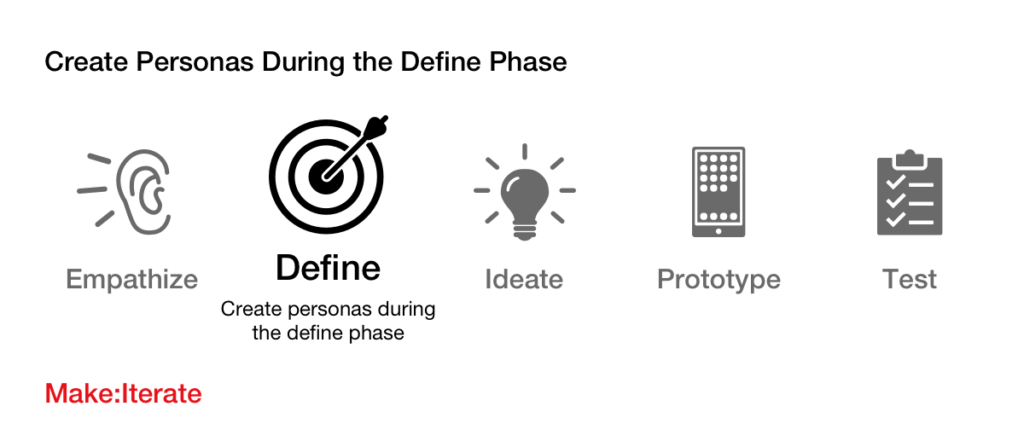To design products and services people love, you need to think from the customer’s perspective. You need to understand their needs, wants, and problems. And the best way to do that is by creating customer personas.
In this post, you’ll learn everything you need to know about user personas, and how to use them during the Design Thinking process, to develop products and services your customers love.
What Are Design Thinking Personas?

User personas describe your ideal customer.
They’re based on data about your target audience gathered through UX research. They include a mix of demographic, psychographic, and behavioral data.
Design Thinking personas contain actionable information that guides your decision making throughout the Design Thinking process.
The most powerful user personas are based on empathy and understanding, describing the tasks, needs and goals of the actual user you’re designing for.
Realistic personas help you focus on what’s important and remove assumptions you have about the target user.
They’re actionable descriptions of actual customers that have complex and varied needs.
Evidence-based user personas validated through user research give us confidence that we’re making the right decisions throughout the design thinking process.
Why Should You Create Design Thinking Personas
Making user personas is an essential part of the design thinking process.
They give you a deep understanding of your customers so you can develop products and services that meet their needs.
Personas help keep you focused on the customer throughout the design process, so you keep sight of what’s important.
Make better decisions throughout the Design Thinking process by referring to personas at key decision points.
Stay grounded in actual data that reminds you to stay focused on solving problems relevant to your target audience.
Personas are an excellent tool for building a shared understanding and getting your team on the same page so you can make decisions with the same goals. They’ll also help you to prioritize your efforts and ideas at critical stages.
How to Use Personas During the Design Thinking Process

Personas should be used at every stage of the design thinking process to keep your team focused on the customer’s needs.
They should be discussed at key points throughout the process and used when deciding which direction to take.
They serve as decision making criteria, focus conversations, and anchor brainstorming on an evidence-based and reliable foundation.
The following are some examples of how to use personas:
Use Them as a Starting Point for Brainstorming Ideas
Refer to your personas when developing solutions to problems to ensure that your ideas align with users’ needs and goals. Make the personas visible during ideation so everyone can relate to them. Refer to one of the personas during ideation, or you can conduct numerous brainstorming sessions if you have multiple personas.
Use Them as Filters for Evaluating Ideas
Once you have a list of potential solutions, refer to your personas and evaluate each idea based on how well it meets their needs. Map the ideas to the different data points of the personas to see how well they fit together and where the gaps are
Use Them as a Guide for Developing Solutions
When you get down to the nitty-gritty of making detailed design decisions, user personas can help you stay anchored in research. Once you’ve decided on a solution, you can refer to your personas to ensure it aligns with their needs.
Use Them as a Testing Tool
Use your personas to decide who to recruit for user testing and further research sessions. Test your ideas with different customer groups that match each persona.
Different Types of Design Thinking Personas
A few variations of personas are used for different reasons and circumstances.
They differ slightly in their intended use, but what’s important is that they all contain valuable information about your user base.
You’re on the right track as long as your persona represents a real person and it’s based on real data.
Here are a few examples that might be helpful to your project:
- Proto personas, or hypothetical persona, are used as a starting point when you need more research data.
- The primary persona is the main focus of your design.
- A secondary persona is a person who’s affected but not the focus.
- Anti-persona is a persona that represents a group that your design isn’t intended for.
- A marketing persona is similar to those used by a UX designer, but it has information that helps guide marketing strategy.
Tips for Creating Effective Design Thinking Personas
Quality user personas will serve as the bedrock for all decision making within your team.
They’ll inspire your ideas, guide your evaluation and help you decide who to recruit for user testing and research sessions.
Here are 5 tips on how to create quality design thinking personas:
Start With User Research
Your personas are only as good as the research behind them – A good persona is based on actual data. When developing personas, use a mix of qualitative and quantitative research. Conduct user interviews, surveys, and observations to gather real user data.
Keep It Real
Your personas should be based on accurate data about real people. They should be a realistic representation of your ideal customers. Add some demographic and fictional data to make them believable and memorable – but only if it’s helpful to the product team.
Keep Them Short and Sweet
Your personas should be short, concise and to the point. The more concise they are, the easier it is to use and refer back to them throughout the design process. They should only contain information that will help you make decisions or help you understand the user story and customer experience.
Keep Them Actionable
Your personas should contain information you can use to make decisions throughout the design process. They should focus on tasks and goals you’ve identified through customer conversations. Stay moderate with fictionalizing your personas and avoid losing the impact of real data.
Keep It Current
As your business grows and changes, so does your target audience. Update your personas regularly to ensure they’re always an accurate reflection of your ideal customers.
5 Steps to Create Design Thinking Personas
There are several ways to get the data you need to create meaningful user personas for use in design thinking.
Get a comprehensive picture of your audience using surveys, interviews, focus groups, data and analytics.
Once you have your data, it’s time to start creating your personas. There are several formats for customer personas, but they all have in common that they include actionable goals, needs and pain points, and other helpful information.
Here are 5 steps to creating user personas for use in design thinking:
Do Your Research. Personas should represent a group of real people. They should be evidence-based and created after research. Talk to your customers to find out who they are, why they use your solution, and their habits, behaviors, expectations and assumptions. At the end of your research phase, you’ll have the information you need to create detailed, realistic personas for use in the design thinking process.
Synthesize Your Research. Organize your research findings into themes that provide insight into how different groups of customers think and behave. Consider how the themes are related, how they differ, what type of customer they relate to, and at what stage of the journey they are important. Review the topics until you have strong ideas about your audience.
Organize Them Into Persona Groups. Organize the topics into groups that represent different customer segments. Name the groups and highlight the key insights. Note what makes each group different and what makes them similar.
Refine Your Persona Groups. Prioritize your personas based on how relevant they are to your project. Select one group as the primary persona, select some as secondary personas, and show how they relate.
Make Them Real. Now that your groups are categorized, you can continue your research and fill them in with more relevant data. Write descriptions for the personas, what motivates them, what problems they have, why they use your product, and how they behave. Keep these descriptions short and meaningful so you can refer back to them quickly.
Related and Similar Tools and Techniques
Journey Map

Journey maps show us what our customers experience over time. They show us the steps a customer goes through in their journey and compile useful information about what they experience at each stage. We use this information to identify opportunities to improve our customers’ experiences. The journey map combines quantitative and qualitative research to help the UX team understand the user experience and user behavior of a potential user based on a customer persona.
Empathy Map

An empathy map helps us to visualize our users needs. They organize our research findings into categories that tell us what a user group thinks, feels, says, and does. We refer to empathy maps throughout the process to guide our thinking and focus on what matters most to our customers. The empathy map is popular in UX design and product design as a way for the design team to understand user needs alongside the UX persona.
How Do I Get Started?
Here’s a template you can use to get started on your personas.
It’s perfectly fine, to begin with a hypothetical persona based on your assumptions.
This can help you identify who you need to speak to so that you can start collecting real data.
As you speak to more and more customers, you can validate and improve them over time.

Conclusion
Creating customer personas is an essential part of the design thinking process.
By taking the time to understand your target audience deeper with qualitative personas, you’ll be able to design better products and services that meet their needs.
In addition, using personas throughout the design process helps you keep the customer in mind, so you keep sight of what’s important.





